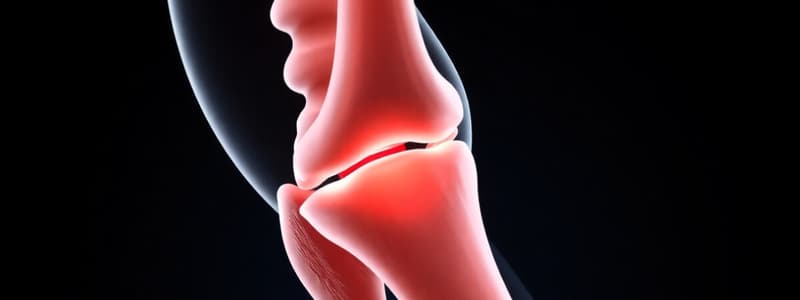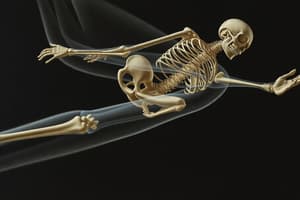Podcast
Questions and Answers
What is the primary purpose of joint mobilization?
What is the primary purpose of joint mobilization?
- To improve cardiovascular fitness
- To decrease pain or increase joint mobility (correct)
- To promote muscle hypertrophy
- To increase joint strength
Rolling of the humerus during shoulder flexion occurs in the same direction as the sliding of the glenoid fossa.
Rolling of the humerus during shoulder flexion occurs in the same direction as the sliding of the glenoid fossa.
False (B)
Define osteokinematics.
Define osteokinematics.
Movement of the bony lever such as flexion, extension, abduction, adduction, and rotation.
The convex humerus is moving on the ________ glenoid.
The convex humerus is moving on the ________ glenoid.
Match the following joint motions with their definitions:
Match the following joint motions with their definitions:
Which mobilization grades are used for decreased pain?
Which mobilization grades are used for decreased pain?
Closed pack position refers to a position of maximum joint congruence.
Closed pack position refers to a position of maximum joint congruence.
What is a common contraindication for stretching?
What is a common contraindication for stretching?
For rolling, spinning, or sliding to occur, there must be adequate ________ or joint play.
For rolling, spinning, or sliding to occur, there must be adequate ________ or joint play.
During shoulder flexion, in which direction does the humeral head roll?
During shoulder flexion, in which direction does the humeral head roll?
What is the primary purpose of Glide and Distraction in joint mobilization?
What is the primary purpose of Glide and Distraction in joint mobilization?
Grade IV mobilization is primarily used to modulate pain.
Grade IV mobilization is primarily used to modulate pain.
What effect does joint-based manual therapy have on inflammatory markers?
What effect does joint-based manual therapy have on inflammatory markers?
The pattern of restricted motion in a joint with inflammation is known as a __________ pattern.
The pattern of restricted motion in a joint with inflammation is known as a __________ pattern.
Match the mobilization grades with their descriptions:
Match the mobilization grades with their descriptions:
Which mobilization grade is primarily utilized to maintain joint play?
Which mobilization grade is primarily utilized to maintain joint play?
Hypeormobility is an indication for joint mobilization.
Hypeormobility is an indication for joint mobilization.
Name one non-specific mechanism that can enhance the effect of joint-based manual therapy.
Name one non-specific mechanism that can enhance the effect of joint-based manual therapy.
Distraction force is applied __________ to the treatment plane.
Distraction force is applied __________ to the treatment plane.
What is a contraindication for performing Grade III and IV mobilizations?
What is a contraindication for performing Grade III and IV mobilizations?
Which of the following describes the open pack position?
Which of the following describes the open pack position?
The convex surface of the patello-femoral joint is the femur.
The convex surface of the patello-femoral joint is the femur.
What is the degrees of flexion for the tibio-femoral resting position?
What is the degrees of flexion for the tibio-femoral resting position?
The convex surface of the hip joint is the ______ and the concave surface is the acetabulum.
The convex surface of the hip joint is the ______ and the concave surface is the acetabulum.
Match the following mobilization techniques with their intended outcomes:
Match the following mobilization techniques with their intended outcomes:
Which statement best describes joint mobilization?
Which statement best describes joint mobilization?
A posterior glide can be used to increase knee flexion ROM.
A posterior glide can be used to increase knee flexion ROM.
In order to achieve closed-chain ankle dorsiflexion, the tibia must be mobilized in which direction?
In order to achieve closed-chain ankle dorsiflexion, the tibia must be mobilized in which direction?
The humero-ulnar joint has a flexion resting position with a degree of ______ and supination degree of ______.
The humero-ulnar joint has a flexion resting position with a degree of ______ and supination degree of ______.
Which mobilization technique is used to correct a laterally displaced patella?
Which mobilization technique is used to correct a laterally displaced patella?
Study Notes
Osteokinematics and Arthrokinematics
- Osteokinematics refers to the movement of the bony lever, e.g., flexion, extension, abduction, adduction, rotation.
- Arthrokinematics refers to the motion of the bone surface, e.g., rolling, sliding, spinning.
- Adequate capsular laxity is necessary for rolling, spinning, or sliding to occur.
Principles of Arthrokinematics
- Rolling always occurs in the direction of the moving bone.
- Rolling without sliding leads to compression on one side of the joint and distraction on the other.
- Pure rolling does not occur in healthy joints; it's accompanied by sliding or spinning.
Concave and Convex Rules
- Convex moving on concave: roll and slide occur in opposite directions.
- Concave moving on convex: roll and slide occur in the same direction.
Shoulder Flexion
- To improve shoulder flexion, the humerus must be mobilized in a caudal direction.
- The humerus is the mobile component, while the glenoid fossa is the static component.
- The humeral head rolls upward in flexion, while the slide occurs downward.
Roll Without Slide
- A tight capsule restricts normal arthrokinematics, leading to compression.
Glide and Distraction
- Glide is parallel to the treatment plane.
- Distraction is perpendicular to the treatment plane.
Treatment Techniques
- Distraction force is applied perpendicular to the treatment plane.
- Glide force is performed parallel to the treatment plane.
Long Axis Traction
- Can be performed parallel or perpendicular.
Biomechanical and Neurophysiological Effects of Joint Mobilization
- Mechanical Effects:
- Peripheral mechanisms
- Spinal mechanisms
- Supra-spinal mechanisms
- Non-specific mechanisms (Placebo effect, patient expectation)
Mechanical Effects of Mobilization
- Mechanical pressure on tissue can decrease spasm and increase ROM.
- Mobilization can restore normal arthrokinematics and maintain or restore accessory motion.
Peripheral Mechanisms
- Joint based manual therapy can reduce blood and serum level cytokines.
- Changes in blood levels of b-endorphin, anandamide, serotonin, and endogenous cannabinoids have been observed after manual therapy.
Spinal and Supraspinal Mechanisms
- Mobilization can lead to hypoalgesia, changes in motor neuron pool activity, and descending inhibition due to changes in the opioid system.
Non-Specific Responses
- The placebo effect plays a significant role in treatment outcomes.
- Patient expectations influence the effectiveness of joint-based manual therapy.
Maitland Joint Mobilization Grading Scale
- Grade I: Oscillating small amplitude movement at the beginning of the range of motion.
- Grade II: Oscillating large amplitude movement in the mid-range of movement without reaching the first tissue restriction.
- Grade III: Oscillating large amplitude movement from the middle to the end range, into the tissue resistance.
- Grade IV: Oscillating small amplitude at the end range of movement.
- Grades I and II: Primarily used to modulate pain.
- Grades III and IV: Primarily used to increase ROM.
Sustained Techniques
- Grade I - II: Inhibit pain by stimulating joint mechanoreceptors and unloading/decompressing the joint.
- Grade II: Maintains joint play when ROM is not allowed.
- Grade III - IV: Stretch joint structures and increase joint play.
Capsular Pattern
- A limitation of ROM in a specific pattern can be found in inflamed joints.
- The pattern is consistent for each joint, although it can vary significantly.
- This pattern can point to underlying conditions affecting the joint capsule.
Indications for Joint Mobilization
- Presence of dysfunction.
- Relief of pain, via neurophysiological effects
- Hypomobility.
Contraindications
- Contraindications to stretching (Grades III & IV).
- Hypermobility.
- Joint effusion.
- Inflammation.
- Excessive pain or resistance.
- Empty end-feel and severe multidirectional spasm.
Precautions
- Bone disease.
- Malignancy.
- Unhealed fracture.
- Weakened connective tissue.
- Elderly, steroid use, systemic diseases (RA), early healing.
- Total joint replacements.
- Physique (size difference between provider and patient).
- Patient unable to relax.
Closed Pack vs Open Pack
- Closed-Pack: Position of maximal joint surface approximation (e.g., full knee extension).
- Open-Pack: Position of greatest relaxation and the position the joint assumes when effused (e.g., 20 degrees of knee flexion).
Joint Resting Positions
- Glenohumeral: Abduction: 55 degrees, H Add: 30 degrees (plane of scapula). Convex: Humerus, Concave: Glenoid.
- Humeroulna: Flexion: 70 degrees, Supination: 10 degrees. Convex: Humerus, Concave: Ulna.
- Radiocarpal: Neutral, slight ulnar deviation. Convex: Carpals, Concave: Radius.
- MCP, PIP, DIP: Slight flexion. Convex: Proximal, Concave: Distal.
- Hip: Flexion: 30 degrees, Abduction: 30 degrees, slight ER. Convex: Femur, Concave: Acetabulum.
- Tibiofemoral: Flexion: 25 degrees. Convex: Femur, Concave: Tibia.
- Patellofemoral: Extension. Convex: Patella, Concave: Femur.
- Talocrural: Plantarflexion: 10 degrees. Convex: Talus, Concave: Tibia and Fibula.
Procedure and Principles of Joint Mobilization
- Patient and therapist should be relaxed in a correct position.
- Use proper body mechanics, ensuring the mobilizing part acts as a unit.
- Begin the mobilization in the resting position.
- Stabilize the proximal segment.
- Mobilize with hands close to the joint line.
- Avoid pain.
- Never mobilize in the closed pack position.
- Use firm grip, but light pressure.
- Visualize the joint surfaces and apply the appropriate technique.
- Use minimal force needed to achieve goals.
- Obtain traction/distraction where possible.
Shoulder Mobilization
- Distraction can be used with convex on concave motion.
- Caudal glide can increase flexion and abduction ROM.
- Posterior glide can increase flexion and internal rotation ROM.
- Anterior glide can increase extension and external rotation ROM.
Scapulothoracic Mobilization
- All scapular motions can be achieved with mobilization.
Knee Mobilization
- Distraction can be used to increase comfort during PROM.
- Posterior glide can increase flexion ROM.
- Anterior glide can increase knee extension ROM.
- Posterior glide of the femur on the tibia is the same concept as the tibiofemoral A/P glide.
Patellofemoral Mobilization
- Distal glide can increase flexion.
- Superior glide can increase extension.
- Medial glide and medial tilt can correct laterally displaced patella.
Ankle Mobilization
- Talocrural distraction can be used.
- Posterior glide increases plantarflexion.
- Anterior glide increases dorsiflexion.
Closed-Chain Ankle Dorsiflexion
- To achieve closed-chain ankle dorsiflexion, the tibia must be mobilized posteriorly.
Studying That Suits You
Use AI to generate personalized quizzes and flashcards to suit your learning preferences.
Description
Test your understanding of osteokinematics and arthrokinematics, focusing on the principles of joint movement, concave-convex rules, and their application in shoulder flexion. This quiz will challenge your knowledge on how bone motion and joint mechanics interact for effective mobility.




